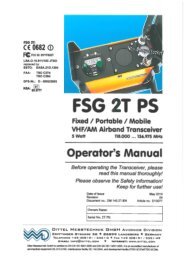EFIS-D6 Installation Guide
EFIS-D6 Installation Guide
EFIS-D6 Installation Guide
Create successful ePaper yourself
Turn your PDF publications into a flip-book with our unique Google optimized e-Paper software.
4. <strong>EFIS</strong> CALIBRATION AND CONFIGURATION<br />
During manufacture, your <strong>EFIS</strong>-<strong>D6</strong> underwent a comprehensive calibration, verification, and<br />
burn-in routine that minimizes setup time and ensures that your <strong>EFIS</strong>-<strong>D6</strong> meets Dynon’s<br />
stringent performance specifications. To account for your individual preferences and your<br />
aircraft’s particular setup, there are a few simple calibration and configuration steps that you<br />
must complete before using your <strong>EFIS</strong>-<strong>D6</strong>. This section takes you through these steps to make<br />
sure that you have properly installed and configured your <strong>EFIS</strong>-<strong>D6</strong>.<br />
It is your responsibility to fly your plane safely while performing any configuration or<br />
calibration in flight. The best scenario would include a second person to perform any<br />
necessary steps on the unit.<br />
Ensuring Proper <strong>Installation</strong><br />
Turn your unit on by energizing the aircraft power to which it is connected. Ensure that the<br />
screen is bright and readable and that all instrument displays appear. If a desired display item is<br />
not present, refer to the User’s <strong>Guide</strong> to use the CLUTTR feature to display the missing item.<br />
Setting Zero Pitch (In flight)<br />
For the purposes of this setting, level is defined as the attitude at which the aircraft’s<br />
longitudinal axis is parallel to the ground. For most aircraft, the attitude the aircraft<br />
assumes at normal cruise speeds will be acceptable. Additionally, this feature should not<br />
be used to “zero out” pitch when the aircraft is at an attitude other than level. Do not<br />
think of this adjustment as you would the parallax adjustment on a normal attitude<br />
indicator. Instead, think of it as a calibration step which is not changed often.<br />
With your aircraft flying straight and level, enter the <strong>EFIS</strong> > SETUP > PITCH menu. Press INC<br />
or DEC until the horizon line intersects the center of the crosshairs. It is important that this be<br />
done while the aircraft is level to ensure proper pitch and roll display throughout all maneuvers.<br />
Compass Heading Calibration<br />
This section guides you through the calibration and configuration of your magnetic heading<br />
indication. Prior to calibrating your <strong>EFIS</strong>-<strong>D6</strong>’s internal sensors or remote EDC-D10A, you must<br />
configure the local magnetic inclination and magnetic intensity as described in the sections<br />
below.<br />
SETTING MAGNETIC INCLINATION ANGLE AND INTENSITY (REQUIRED)<br />
To calibrate your <strong>EFIS</strong>-<strong>D6</strong> heading, you must input your location’s current magnetic<br />
inclination angle and intensity. Before doing this, you must obtain these two values for<br />
the geographic location where you will be performing the calibration. Note that this<br />
procedure only needs to be done once, prior to magnetic calibration. Moving the aircraft<br />
to another location does not require repeating this procedure.<br />
<strong>EFIS</strong>-<strong>D6</strong> <strong>Installation</strong> <strong>Guide</strong> 4-1
















